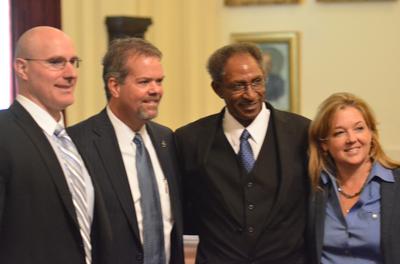Willie Grimes: Free At Last

In 1987, an African-American male forced his way into the home of an elderly woman in Hickory, North Carolina. The intruder warned that he had a knife in his pocket and he would cut her if she did not cooperate. He proceeded to rape her twice before leaving out her back door. On his way out the door, he went through her fruit bowl and took a few pieces with him.
The night of the rape, the victim gave a description of the perpetrator to law enforcement. She was unable to identify anyone in the lineup shown to her that night. Willie’s photo was not included in that lineup as he was not yet a suspect. A crime scene technician processed the scene for trace evidence, including fingerprints, hair, and semen. Latent prints were recovered from the fruit that the perpetrator had touched and left on the table. African-American hairs were found on the victim’s bedsheet.
Two days later, the victim spoke to her neighbor about the assault. The neighbor said she might know who raped her, but she would only give the information directly to law enforcement. She later told them the description matched her sister’s ex-boyfriend, Willie Grimes. The neighbor was later paid $1,000 for that information. It was not the first case for which she had given information.
At trial, the evidence against Willie consisted of an extremely weak cross-race identification made by the victim and testimony of a lab analyst that the hairs found at the scene were “microscopically consistent” with Willie. The identification was so shaky that when asked during voir dire to make an in-court identification of her rapist, the victim pointed to Willie’s defense attorney. Willie had eight alibi witnesses testify that he was miles away from the crime scene with friends when the crime occurred. Prior to trial, the defense was never told that the fingerprints on the fruit touched by the perpetrator did not match Willie.
The jury deliberated for an hour before finding Willie guilty of two counts of first-degree rape and one count of second-degree kidnapping. He was sentenced to life plus nine years in prison. Willie filed dozens of postconviction motions in state and federal court proclaiming his innocence.
 In 2003, he contacted the Center for help with his case. The Center knew the key to Willie’s case was subjecting the physical evidence to modern testing, so Center staff made numerous inquiries to law enforcement, the Clerk’s office, and the District Attorney’s office, all of which met with assurances that all evidence had been destroyed. No court order for destruction was ever located.
In 2003, he contacted the Center for help with his case. The Center knew the key to Willie’s case was subjecting the physical evidence to modern testing, so Center staff made numerous inquiries to law enforcement, the Clerk’s office, and the District Attorney’s office, all of which met with assurances that all evidence had been destroyed. No court order for destruction was ever located.
In 2007, the Center provided Willie’s case to the North Carolina Innocence Inquiry Commission to be used as a mock training case for new Commission members. After receiving a federal grant specifically designated to assist with DNA testing in old cases, the Commission staff conducted an evidence search in the case. The search led them to the discovery that the latent prints still existed in law enforcement’s investigation file. The prints were uploaded into AFIS, which resulted in a match to a man with a lengthy criminal record–including multiple assaults on women. Further investigation showed that man’s photo was in the original lineup shown to the victim, but his photo was outdated and was not representative of how he looked at the time of the rape.
After proceeding through the Commission process, Willie was represented by the Center and co-counsel Robert Campbell before a three-judge panel in October 2012. After four days of evidence, closing arguments were scheduled for the morning of October 5th, beginning with District Attorney Jay Gaither. Mr. Gaither stated that, after hearing the evidence, he could not in clear conscience argue against Willie’s innocence. He then apologized to Willie on behalf of the State of North Carolina. The three-judge panel declared Willie innocent of the rape and kidnapping charges and ordered that his name be removed from the Sex Offender Registry immediately.
Willie spent nearly a quarter of a century in prison for a crime that he did not commit. He always maintained his innocence. He never wavered even when he received attractive plea offers. He refused to take sex offender classes where he would have had to admit guilt, keeping him from being parole eligible and in prison an additional ten years. Only an innocent man has that kind of endurance.
Read more about Willie’s case in the NC State Bar Journal.
Click here to read about Ghost of an Innocent Man, Benjamin Rachlin’s book about Willie Grimes’ exoneration,
Willie Grimes Case in the Media
Exonerated Man to Receive Additional $2.2 Million – Jan 16, 2019
Man Awarded $3.25 Million After Serving 24 Years for a Rape He Did Not Commit – Aug 24, 2016
Willie Grimes and the Criminal Justice System 5 Years After His Exoneration – Nov 15, 2017
24 Years Wrongfully Imprisoned Shaped Willie Grimes Into Man He is Today – Apr 29, 2015
Man Declared Innocence of 1987 Rape for Which He had Served More Than 24 Years – Oct 9, 2012
Get in Touch. Get Involved.
